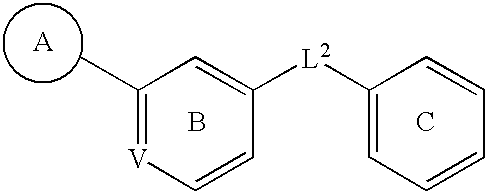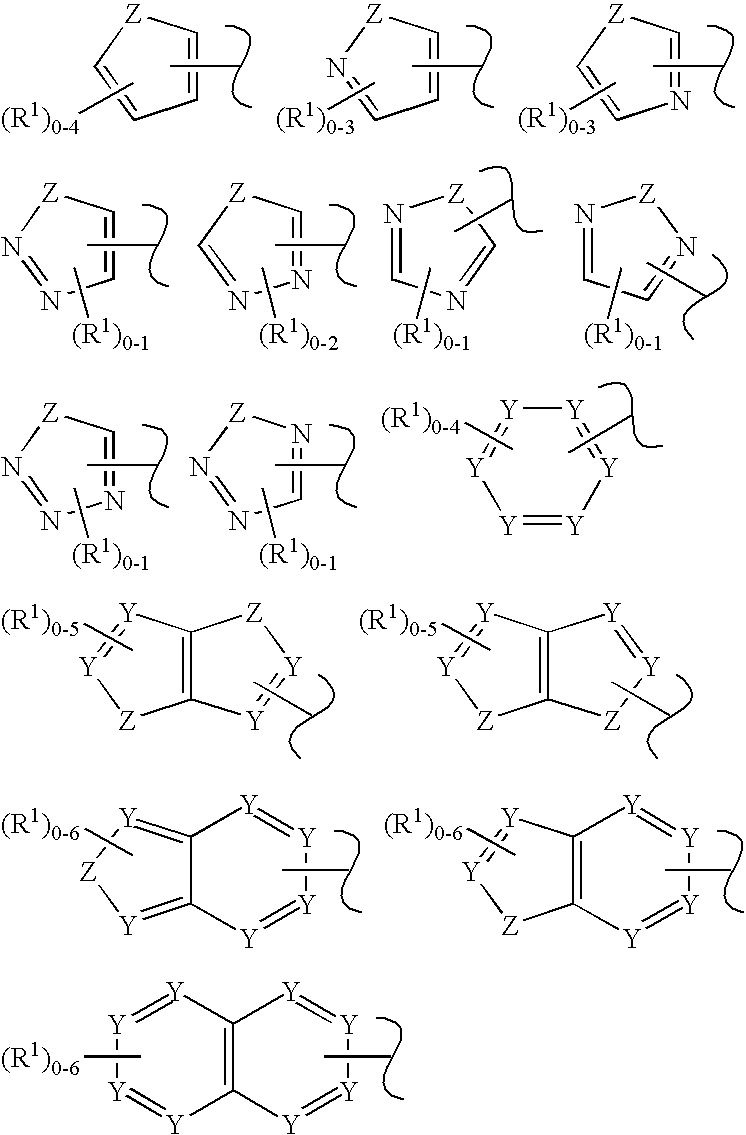C-Kit Modulators And Methods Of Use
a technology of protein kinase and modulator, which is applied in the direction of drug composition, sense disorder, cardiovascular disorder, etc., can solve the problems of autophosphorylation of kit, ligand-independent tyrosine kinase activity, and altered cellular properties, so as to improve the specificity of the agent used
- Summary
- Abstract
- Description
- Claims
- Application Information
AI Technical Summary
Benefits of technology
Problems solved by technology
Method used
Image
Examples
example 1
Synthesis of N-[4-chloro-3-(trifluoromethyl)phenyl]-2-{(3-(1H-tetrazol-1-yl)-phenyl]oxy}acetamide 4
[0191]
[0192]3-Aminophenoxyacetic acid 2: To a 2 L pressure vessel was added 3-nitrophenoxyacetic acid 1 (21.7 g, 110 mmol, 1.0 eq.) and methanol (600 mL). The resulting solution was purged with N2 for 5 min. 10% Pd / C (900 mg) was added to the solution and the vessel was placed on a Parr hydrogenator at 50 psi for 3 h. After removal from the Parr apparatus, the reaction mixture was gray in color, indicating the precipitation of product. DMF (400 mL) was added and was stirred until it was evident that the precipitated product had dissolved in the solvent phase. The Pd / C was removed by filtration and the filtrate was concentrated under high vacuum to yield a dark brown solid (14 g, 76%). LC / MSD (HP Series 1100 MSD) MS (ES+) m / z 168.0 (M+H)+1 1H-NMR, Varian 400 MHz (DMSO-d6) δ 7.93 (s, 1H), 6.86 (t, 1H), 6.14-5.99 (m, 3H), 4.50 (s, 2H) ppm.
[0193]3-Tetrazol-1-ylphenoxyacetic acid 3: To a 25...
example 2
Synthesis of N-[4-chloro-3-(trifluoromethyl)phenyl]-2-{[3-(1H-1,2,3-triazol-1-yl)phenyl]oxy}acetamide 8
[0195]
[0196](3-azidophenoxy)-acetic acid 5: To a 100 mL recovery flask was added 3-aminophenoxyacetic acid 2 (2.00 g, 12.0 mmol, 1.0 eq.) and a stirbar. Acetic acid (5 mL), conc. HCl (2 mL) and H2O (3 mL) were added to the flask. The reaction mixture was cooled to 0° C. upon which a solution of NaNO2 (0.908 g, 13.2 mmol, 1.1 eq.) in H2O (3 mL) was added over a period of 20 sec. The mixture was stirred for 5 minutes. A solution of NaN3 (0.855 g, 13.2 mmol, 1.1 eq.) in H2O (3 mL) was added slowly to the reaction mixture upon which the mixture foamed. The reaction mixture was stirred at 0° C. for 30 min and at room temperature for an additional 1 h. A light brown solid precipitates out of solution. The suspension was filtered and washed with cold H2O to yield a light-brown solid (1.48 g). Upon drying, the more precipitate formed in the filtrate. The precipitate was refiltered to yield...
example 3
Synthesis of N-[4-chloro-3-(trifluoromethyl)phenyl]-2-[3-(1H-tetrazol-1-yl)phenyl]hydrazine carboxamide 13
[0200]
[0201]1-(3-nitrophenyl)-1H-tetrazole 10: To a 250 mL recovery flask was added 3-nitroaniline 8 (10.00 g, 72.4 mmol, 1.0 eq.) and a stirbar. Triethylorthoformate (38.5 mL, 232 mmol, 3.2 eq.) was added followed by sodium azide (5.88 g, 90.5 mmol, 1.25 eq.) and acetic acid (66.0 mL, 1.16 mmol, 16 eq). The viscous mixture was heated at 80° C. in an oil bath. Upon heating, the mixture solidified. Additional acetic acid (70 mL) was added and the resulting suspension was agitated with a spatula. While heating for 2 h the reaction mixture became homogeneous. The reaction mixture was removed from the oil bath and transferred to a 500 mL Erlenmeyer flask. The flask was cooled to 0° C. in an ice bath upon which H2O (70 mL) and 6N HCl (30 mL) was added. In a separate flask, a solution of NaNO2 (3.5 g) in H2O (15 mL) was prepared. The NaNO2 solution was added slowly to the reaction mix...
PUM
 Login to View More
Login to View More Abstract
Description
Claims
Application Information
 Login to View More
Login to View More - R&D
- Intellectual Property
- Life Sciences
- Materials
- Tech Scout
- Unparalleled Data Quality
- Higher Quality Content
- 60% Fewer Hallucinations
Browse by: Latest US Patents, China's latest patents, Technical Efficacy Thesaurus, Application Domain, Technology Topic, Popular Technical Reports.
© 2025 PatSnap. All rights reserved.Legal|Privacy policy|Modern Slavery Act Transparency Statement|Sitemap|About US| Contact US: help@patsnap.com



